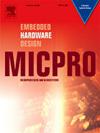Scala为Chisel定义了硬件生成器
IF 2.6
4区 计算机科学
Q3 COMPUTER SCIENCE, HARDWARE & ARCHITECTURE
引用次数: 0
摘要
我们用硬件描述语言如VHDL和SystemVerilog来描述数字硬件设计。这两种语言都是在20世纪80年代发展起来的,尽管定期更新,但仍然保持着当时的风格。它们缺乏编写更多可配置生成器的结构,而不仅仅是操作的位数。Chisel是一种基于Scala的硬件构造语言,可以帮助编写硬件生成器。硬件生成器并不是一个新概念。脚本语言,如Perl和TCL,通常用于从其他系统描述源生成VHDL或Verilog代码。然而,混合两种语言并在生成器代码中嵌入VHDL或Verilog字符串是不可扩展的。由于Chisel嵌入在Scala中,我们可以使用与描述数字逻辑相同的语言/环境来编写生成器。本文探讨了不同的例子和模式来描述可参数化的硬件生成器。我们相信,软件开发的实践可以提高硬件设计人员的生产力,以构建和测试下一个十亿晶体管芯片。本文章由计算机程序翻译,如有差异,请以英文原文为准。
Scala defined hardware generators for Chisel
We describe digital hardware designs in hardware description languages such as VHDL and SystemVerilog. Both languages were developed in the 1980s and, although regularly updated, are still in the style of their time. They lack the constructs to write more configurable generators than just the number of bits for an operation. Based on Scala, Chisel is a hardware construction language that helps to write hardware generators.
Hardware generators are not a new idea. Scripting languages, such as Perl and TCL, are often used to generate VHDL or Verilog code from other sources of system description. However, mixing two languages and embedding VHDL or Verilog strings in generator code is not scalable.
As Chisel is embedded in Scala, we can write the generators using the same language/environment as we use to describe the digital logic. This paper explores different examples and patterns to describe parameterizable hardware generators. We are confident that practices from software development can improve the productivity of hardware designers to build and test the next billion transistor chips.
求助全文
通过发布文献求助,成功后即可免费获取论文全文。
去求助
来源期刊

Microprocessors and Microsystems
工程技术-工程:电子与电气
CiteScore
6.90
自引率
3.80%
发文量
204
审稿时长
172 days
期刊介绍:
Microprocessors and Microsystems: Embedded Hardware Design (MICPRO) is a journal covering all design and architectural aspects related to embedded systems hardware. This includes different embedded system hardware platforms ranging from custom hardware via reconfigurable systems and application specific processors to general purpose embedded processors. Special emphasis is put on novel complex embedded architectures, such as systems on chip (SoC), systems on a programmable/reconfigurable chip (SoPC) and multi-processor systems on a chip (MPSoC), as well as, their memory and communication methods and structures, such as network-on-chip (NoC).
Design automation of such systems including methodologies, techniques, flows and tools for their design, as well as, novel designs of hardware components fall within the scope of this journal. Novel cyber-physical applications that use embedded systems are also central in this journal. While software is not in the main focus of this journal, methods of hardware/software co-design, as well as, application restructuring and mapping to embedded hardware platforms, that consider interplay between software and hardware components with emphasis on hardware, are also in the journal scope.
 求助内容:
求助内容: 应助结果提醒方式:
应助结果提醒方式:


